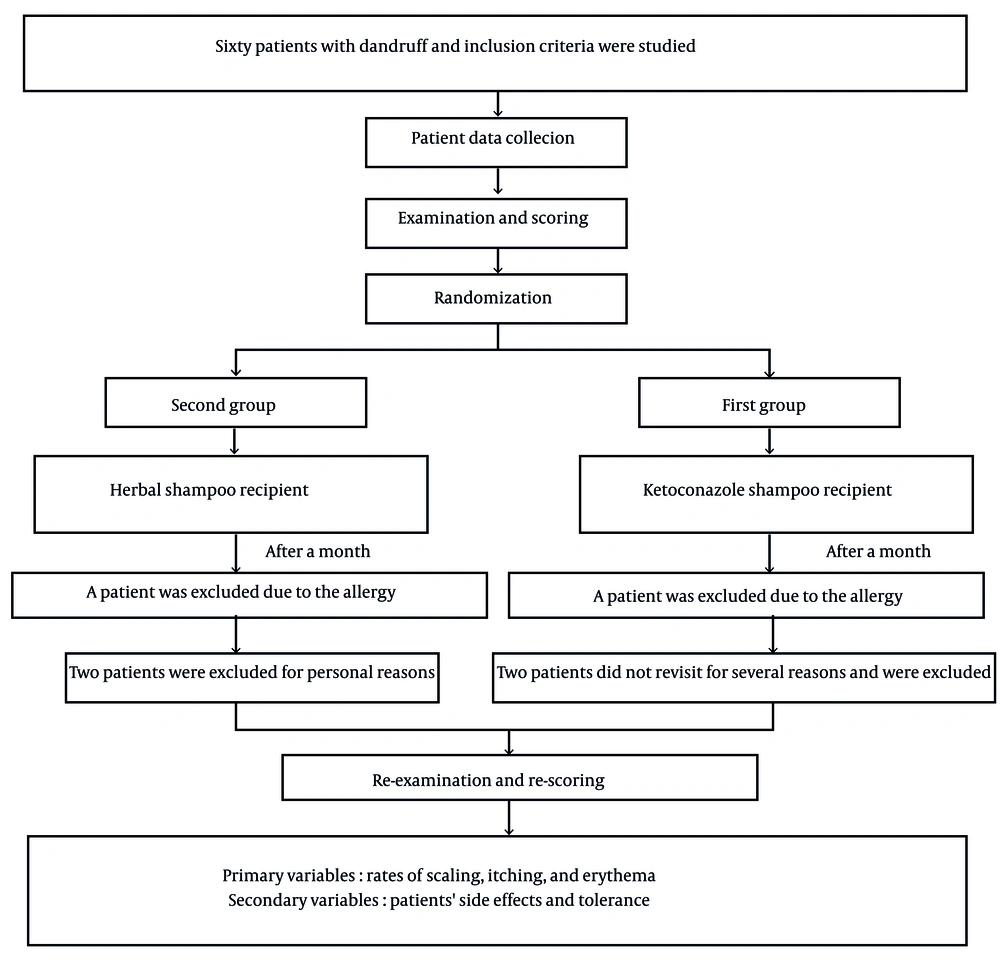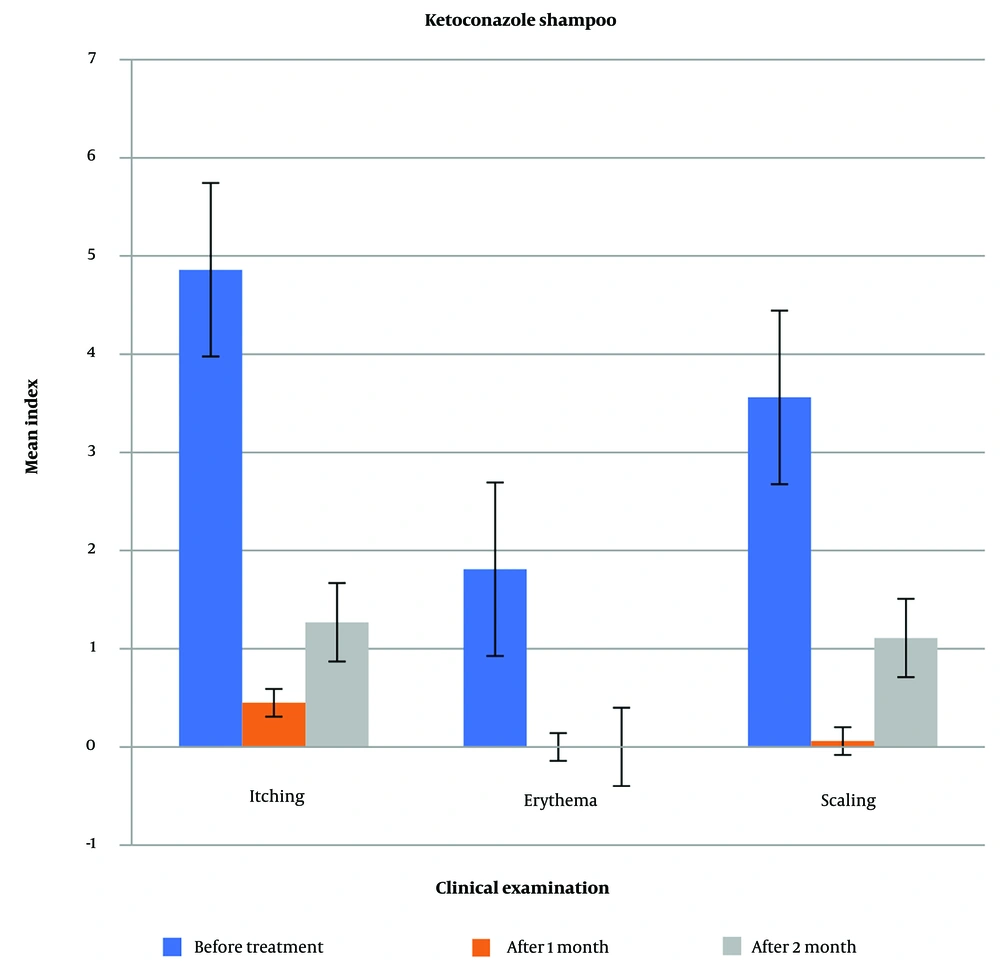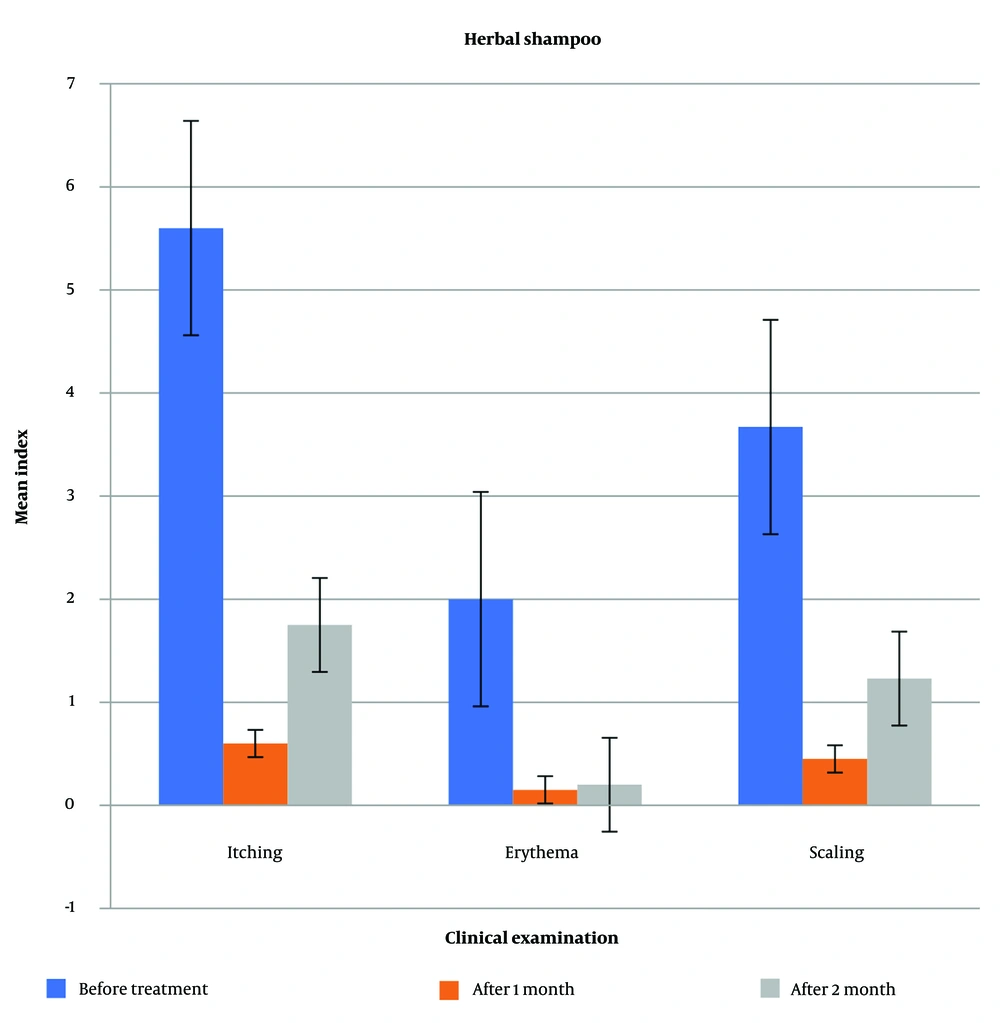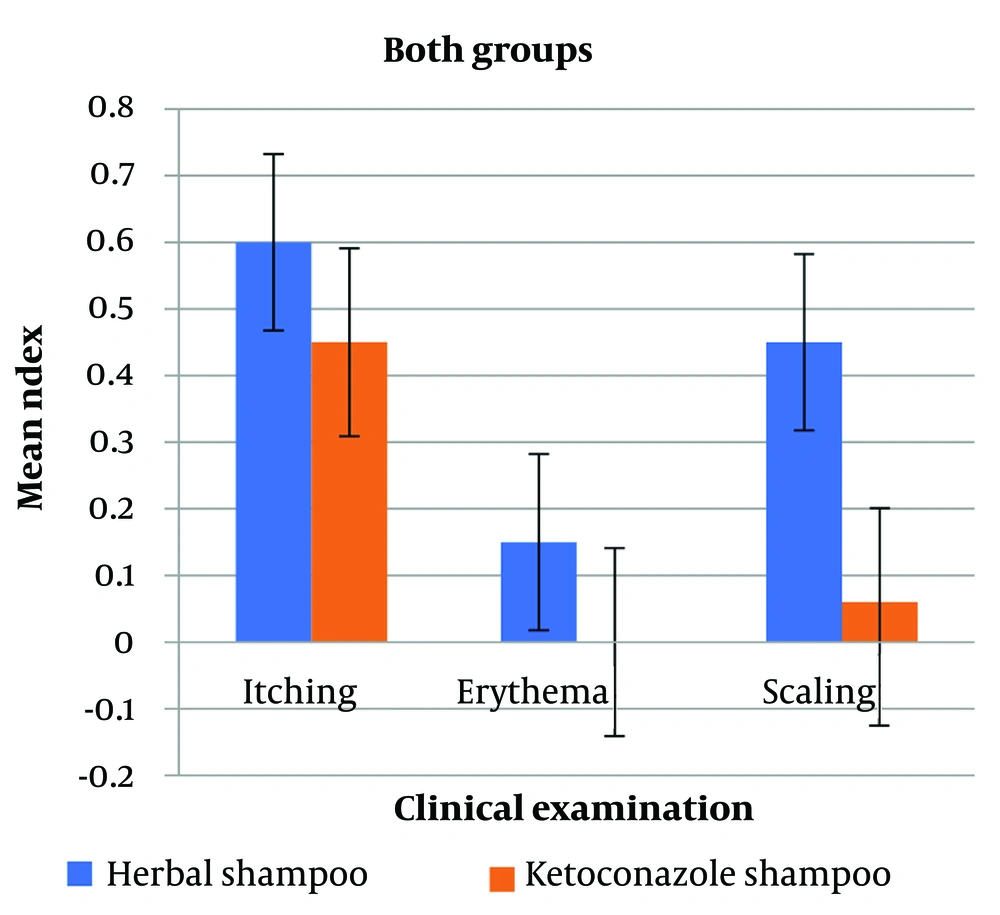1. Background
Dandruff and scalp seborrheic dermatitis (SD) are disorders that occur in areas rich in sebaceous glands, including the chest, face, and scalp. Seborrheic dermatitis is characterized by large, yellow, greasy scales, itching, and redness. Individuals with dandruff typically have overactive sebaceous glands. Generally, three factors contribute to dandruff: (1) Hyperactivity of sebaceous glands, (2) Malassezia fungus, and (3) individual sensitivity rooted in genetics (1). Malassezia furfur is a common saprophytic, polymorphic, and lipophilic fungus that thrives in oily areas of the skin, such as the face, head, and upper body. This single-cell fungus is associated with many diseases that temporarily affect the epidermis (2). The most common anti-dandruff treatments are shampoos containing synthetic chemical compounds, which often have side effects. Various drug combinations, such as topical corticosteroids, antifungal compounds, and selenium sulfide, are used to treat this condition (2). Prolonged use of corticosteroids and antifungals can lead to adverse effects, including a burning sensation, skin redness, and hair loss (2). Numerous antifungal plants exist in nature, offering a more reliable, easier, and cost-effective natural treatment for dandruff. Marshmallow, scientifically known as Althaea officinalis, belongs to the Malvaceae family and is a perennial plant, 60 - 120 cm in height (3, 4). This plant contains mucilage, flavonoid glycosides, anthocyanins, phlobatannins, proteins and amino acids, quinones, sterols and steroids, tannins, and terpenoids (3, 4). Marshmallow consumption is recommended for mild inflammation, severe cough, bronchitis, and irritation of the laryngopharyngeal mucosa (3, 4). Additionally, other studies have demonstrated the antimicrobial, antiviral, anti-inflammatory, antioxidant, and anticancer effects of A. officinalis (3, 4). Unani medicine, one of the oldest traditional medicine systems, has used topical Unani drugs for centuries to treat seborrheic dermatitis of the scalp. One of the Unani antifungal topical drugs for SD is A. officinalis. The benefits of using marshmallow to treat dandruff include its antifungal, anti-inflammatory, and scalp-cleansing properties, making it suitable for SD (5). Recent studies have investigated the effect of A. officinalis extract on M. furfur, a cause of dandruff, in laboratory culture media (6). Vinegar is an organic biochemical product. Oxidative fermentation of ethanol produces acetic acid, known as vinegar. Vinegar can be easily obtained from fruits such as grapes, apples, and dates. The antibacterial effect of vinegar is primarily due to the presence of acetic acid. Numerous reports have highlighted the positive impact of vinegar on health promotion and disease prevention (7). Organic acids have garnered significant attention in recent years due to their potent antimicrobial effects. These substances are commonly referred to as safe compounds and exhibit antimicrobial effects due to the presence of a carboxylic group in their structures. Grape vinegar is a natural ingredient containing organic acids (8). This study is crucial to demonstrate the antifungal and anti-dandruff activity of A. officinalis, potentially leading to the development of a new anti-dandruff product.
2. Objectives
The aim of the present study was to compare the efficacy of an anti-dandruff herbal shampoo containing Althaea officinalis and grape vinegar with Ketoconazole in a double-blind, randomized clinical trial.
3. Methods
3.1. Shampoo Preparation
The flowers of marshmallow were purchased and identified by the pharmacognosist of the research team. They were then carefully rinsed with distilled water to remove waste materials, completely dried, and chopped. Large particles were separated using a sieve. Marshmallow powder was extracted using the maceration method with ethanol/H2O (70/30) for 48 hours, and this process was repeated three times consecutively. The extract was evaporated using a rotary evaporator and freeze-dried. Finally, the resulting powder was dissolved in grape vinegar.
The herbal anti-dandruff shampoo was formulated by incorporating the A. officinalis extract and grape vinegar into a standard shampoo base consisting of tragacanth, sulfosuccinate, amodimethicone, glycerol monostearate (GMS), ethylenediaminetetraacetic acid (EDTA), diethanolamine (DEA), and cocamidopropyl betaine, with deionized water (100% V/V) provided according to shampoo standards (pH = 5.5 - 6.5). In the next step, methylparaben, propylparaben, and aromatic essence were added to the formulation to prepare the anti-dandruff shampoo. The pH of the shampoo was evaluated with a pH meter (pH = 5). The viscosity of the shampoo was measured at 3000 centipoises. The shampoo was observed for appearance, including color, odor, and sediment. It was creamy in color, clear, and free of any sediment (9). The stability evaluation of the shampoo was conducted by placing samples at different temperatures (room temperature, refrigerator, hot air oven) for one week. There was no change in color, odor, or appearance (10).
In the control group, 2% Ketoconazole shampoo was used. Ketoconazole and herbal shampoos were similar in packaging and labeling, then divided into groups 1 and 2. Physicians prescribed the shampoo to patients based on the number of labels. Participants, physicians, and the presenter of the shampoo were blinded to the study design and target group contents.
3.2. Study Design
This study was approved by the Ahvaz Jundishapur University of Medical Sciences Ethics Committee. Additionally, the trial was registered in the Iranian Registry of Clinical Trials under the number IRCT20181026041466N2. Sixty patients with dandruff who met the inclusion criteria participated in the research and were randomly divided into two groups. Figure 1 shows the flowchart of participants through each stage of the recent randomized trial.
The inclusion criteria for the study were as follows: Patients with dandruff on the face and scalp diagnosed by a dermatologist, aged 18 - 60 years, and satisfaction with participating in the study. Exclusion criteria included: Patients treated with topical or systemic corticosteroids within a month prior to referral; any allergic reaction to the drug; lack of satisfaction with the drug and collaboration in the study; non-referral for follow-ups; pregnancy and lactation.
A questionnaire was completed for each patient by the physician after a full examination. This questionnaire included patients' demographic characteristics, age, gender, and clinical examinations in terms of scaling, itching, and current erythema. Scaling severity was classified based on dermatologist examinations into: No scaling and obvious dandruff (score 0); scaling and very low dandruff (score 1); scaling and low dandruff (score 2); scaling and moderate dandruff (score 3); scaling and severe dandruff (score 4); and scaling and very severe dandruff (score 5). Erythema was classified as follows: No erythema (score 0), mild erythema (score 1), moderate erythema (score 2), and severe erythema (score 3). The severity of itching was assessed using the visual analog scale (VAS), where patients scored their itch from 0 to 10: Score 0 indicating no itching, and score 10 indicating the worst and most severe itching experienced (11).
Complications of treatment, such as contact dermatitis, exacerbation of erythema or itching, or the emergence of any new symptoms, were explained to patients by the dermatologist. Patients were instructed to stop the medication and visit the dermatologist if symptoms occurred. The occurrence of side effects was investigated at visits.
In the present study, both groups used the shampoo twice a week on their affected head and face, ensuring the shampoo foam remained on the head for 5 minutes before washing, for one month. To follow up on the treatment, patients revisited the center in the 4th and 8th weeks and were examined by the same dermatologist who completed the questionnaire. Recovery rates were measured by comparing patients' scores at the beginning of the visit with post-treatment scores.
3.3. Statistical Tests
Finally, the results of tests and collected data were analyzed using SPSS. The Kolmogorov-Smirnov test was employed to assess the normal distribution of data. Descriptive statistics were used to provide mean and standard deviation indices. Independent and paired t-tests were utilized to compare the means of the two groups before and after treatment in the case of normally distributed variables. The significance level was set at 0.05, and SPSS version 22 was used for the analysis.
4. Results
In the present study, the efficacy of an anti-dandruff herbal shampoo containing A. officinalis and grape vinegar was investigated. Table 1 presents the demographic data of the study population. Sixty patients (28 women and 32 men) were randomly assigned to receive either the drug or placebo. One patient in the group receiving the herbal shampoo and one patient in the Ketoconazole shampoo group were excluded due to an allergy to the medication, and four others were excluded due to incorrect medication use and personal reasons, leaving 54 participants who completed the research. Figure 1 shows the flowchart of participants through each stage of the recent randomized trial.
| Variables | Ketoconazole Shampoo Group | Herbal Shampoo Group |
|---|---|---|
| Gender | ||
| Male | 12 | 16 |
| Female | 18 | 14 |
| Age | ||
| < 20 | 3 | 2 |
| 20 - 30 | 18 | 18 |
| > 30 | 9 | 10 |
Demographic Table of Patients
The results indicated a statistically significant impact of both medications on the rates of scaling, erythema, and itching in both groups after one month (P < 0.05). The mean scaling index decreased in both groups. Initially, it was 3.67 ± 0.76 in the herbal shampoo group, decreasing to 0.45 ± 0.14 and 1.23 ± 0.21 after one and two months, respectively. In the Ketoconazole shampoo group, the mean scaling index was initially 3.56 ± 1.46, decreasing to 0.06 ± 0.03 after one month, and finally 1.11 ± 0.31 at the end of the study. Despite the greater improvement with Ketoconazole shampoo compared to the herbal shampoo, there was no statistically significant difference between the two groups. Additionally, this index was not significantly different between the groups before treatment.
In terms of the erythema scale, results indicated a statistically significant impact of both drugs on this index in both groups after two months (P < 0.05). The mean erythema index decreased in both groups. It was 2 ± 0.68 in the group receiving herbal shampoo before treatment, decreasing to 0.15 ± 0.027 after one month, and 0.2 ± 0.043 at the end of the study. In the Ketoconazole shampoo group, the index was initially 1.81 ± 0.57, decreasing to 0 after one month, and remaining at 0 at the end of the study. Ketoconazole shampoo led to greater improvement than the herbal shampoo, but no statistically significant difference was found between the two groups. There was no significant difference between the groups in terms of this index before treatment.
Regarding itching, the results indicated a statistically significant effect of both drugs on this index in both groups after two months (P < 0.05).
The mean itching index decreased in both groups. In the herbal shampoo group, it was 5.6 ± 1.18 before treatment, decreasing to 0.6 ± 0.24 after one month and 1.75 ± 0.42 at the end of the study. In the Ketoconazole shampoo group, the index was initially 4.86 ± 1.38, decreasing to 0.45 ± 0.011 after one month, and reaching 1.27 ± 0.37 at the end of the study. No statistically significant difference was found between the two groups for this index. Additionally, there was no significant difference between the groups before treatment. Figure 2 shows the improvement rate in the Ketoconazole shampoo group, and Figure 3 shows the improvement rate in the herbal shampoo group. Figure 4 compares the improvement rate in both groups after one month of treatment.
5. Discussion
Dandruff is a scalp disorder characterized by scaling, itching, and redness. Individuals with dandruff often have overactive sebaceous glands that maintain an oily skin surface. Researchers believe that the exact mechanism of dandruff involves the creation of the lipase enzyme. The Malassezia fungus produces lipase, which hydrolyzes fats to oleic acid. Oleic acid then penetrates the epidermis, causing dandruff plaques, itching, and sometimes inflammation (1). Symptoms occur when the lipophilic Malassezia fungus releases free fatty acids from triglycerides in sebaceous glands. These fatty acids penetrate the epidermis and disrupt the skin barrier, leading to a lack of inter-layer water in the skin and causing dandruff (12).
Marshmallow extract has demonstrated a potent antifungal effect against M. furfur, the fungus responsible for dandruff, in laboratory culture media. Motaharinia et al. found that A. officinalis extract exhibited an antifungal effect comparable to Ketoconazole. To investigate this antifungal activity, Ketoconazole and marshmallow extract were prepared and introduced into the culture medium of M. furfur. The minimum inhibitory concentration and minimum bactericidal concentration were calculated for each compound based on visual assessment and colony counting (6).
Some researchers have highlighted the role of A. officinalis as an anti-inflammatory agent for the respiratory tract, digestive system, and skin (13, 14). Additionally, soluble dietary fibers such as mucilage and pectin in marshmallow induce hypolipidemia by increasing bile acid secretion and reducing intestinal cholesterol absorption (15, 16).
The use of shampoos containing synthetic chemical compounds is the most common dandruff treatment, though they often have side effects. This condition can be treated with various medications, including topical corticosteroids, antifungal compounds, and selenium sulfide (3, 4). Previous studies have indicated the effectiveness of zinc compounds in treating seborrheic dermatitis. For instance, Zinc pyrithione-8 shampoo possesses antifungal properties for treating seborrheic dermatitis of the scalp. Soluble Zinc L-cysteate is another compound with anti-seborrheic effects (17).
There are many antifungal plants in nature, making natural dandruff treatment safer, easier, and cost-effective. The present study aimed to treat dandruff using natural medicine. A previous study investigated the effect of a herbal shampoo containing A. officinalis and apple vinegar on resistant seborrheic dermatitis in a 32-year-old female patient. The patient used this shampoo twice a week for 20 minutes per use. Results indicated that this herbal shampoo could improve the condition within a month without any side effects, with complete recovery observed after the fourth month (18). The A. officinalis extract demonstrated significant antifungal activity against M. furfur, the fungus causing dandruff, in a laboratory culture medium (8). In this shampoo, marshmallow was used for its antimicrobial properties, and grape vinegar was used to create an acidic environment.
Previous studies have shown similar effects to the current study. In one study, the effects of an anti-dandruff shampoo containing a combination of Punica granatum L., Rosmarinus officinalis L., Matricaria chamomilla L., Urtica dioica L., Mentha piperita L., and Salvia officinalis L. extracts were tested on 30 patients for two months. The results showed that the herbal shampoo had effects on dandruff removal with fewer side effects (9). Other studies have reported that natural products, including tea tree oil, thyme, Aloe vera, and Mentha, demonstrate anti-dandruff activity through antimicrobial effects (19). In 2018, the anti-dandruff effect of Myrtus communis L. was evaluated in a clinical trial. The results indicated that M. communis is effective in treating dandruff without specific side effects, showing antibacterial, antifungal, and anti-inflammatory effects (11).
The present study compared the effectiveness of this shampoo with a standard dandruff drug (Ketoconazole). The results indicated a statistically significant impact of both treatments on rates of scaling, erythema, and itching after one month, but no significant difference was found between the groups. Ketoconazole shampoo significantly improved scaling compared to the herbal shampoo, while the herbal shampoo provided further improvement in erythema and itching. According to the obtained results, an herbal shampoo containing grape vinegar and A. officinalis extract can be used to treat dandruff as a less costly and less complicated therapy.




